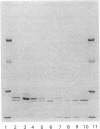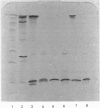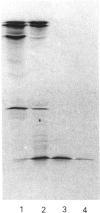Abstract
Cytosolic glutathione S-transferases were purified from the epithelial cells of human small and large intestine. These preparations were characterized with regard to specific activities, subunit and isoenzyme composition. Isoenzyme composition and specific activity showed little variation from proximal to distal small intestine. Specific activities of hepatic and intestinal enzymes from the same patient were comparable. Hepatic enzymes were mainly composed of 25 kDa subunits. Transferases from small intestine contained 24 and 25 kDa subunits, in variable amounts. Colon enzymes were composed of 24 kDa subunits. In most preparations, however, minor amounts of 27 and 27.5 kDa subunits were detectable. Separation into isoforms by isoelectric focusing revealed striking differences: glutathione S-transferases from liver were mainly basic or neutral, enzymes from small intestine were basic, neutral and acidic, whereas large intestine contained acidic isoforms only. The intestinal acidic transferase most probably was identical with glutathione S-transferase Pi, isolated from human placenta. In the hepatic preparation, this isoform was hardly detectable. The specific activity of glutathione S-transferase showed a sharp fall from small to large intestine. In proximal and distal colon, activity seemed to be about equal. In the ascending colon there might be a relationship between specific activity of glutathione S-transferases and age of the patient, activity decreasing with increasing age.
Full text
PDF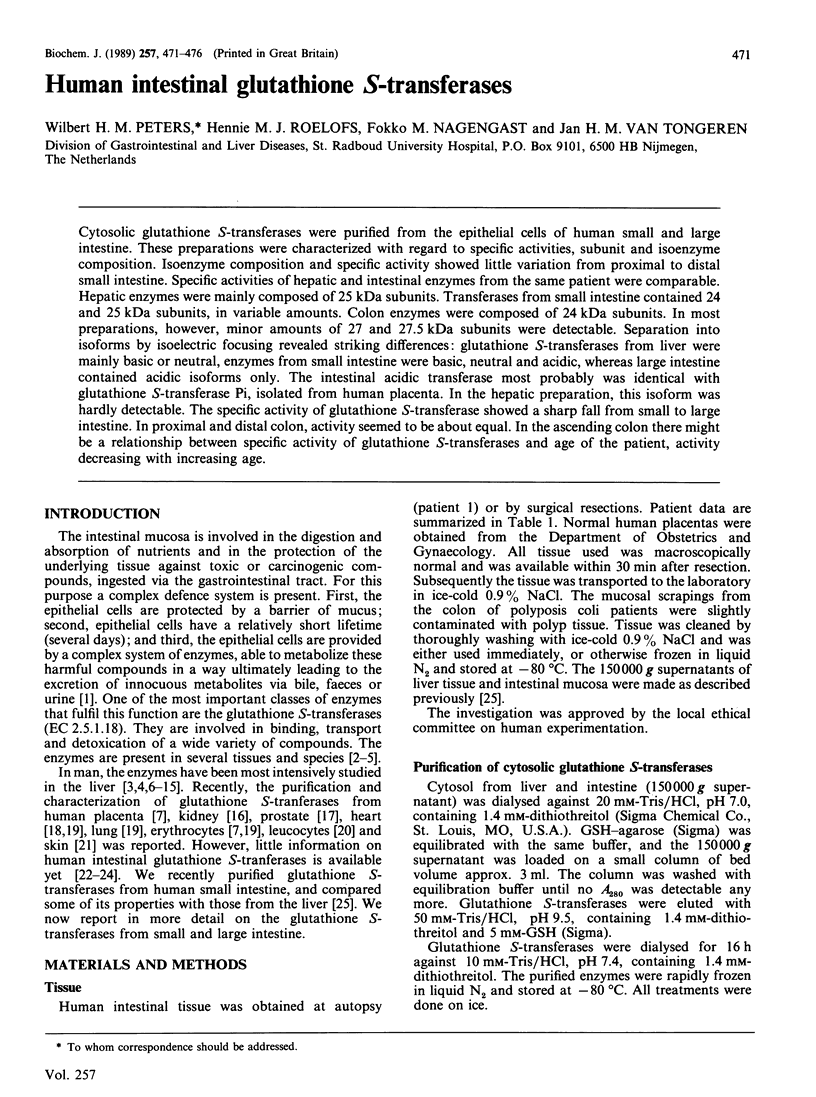
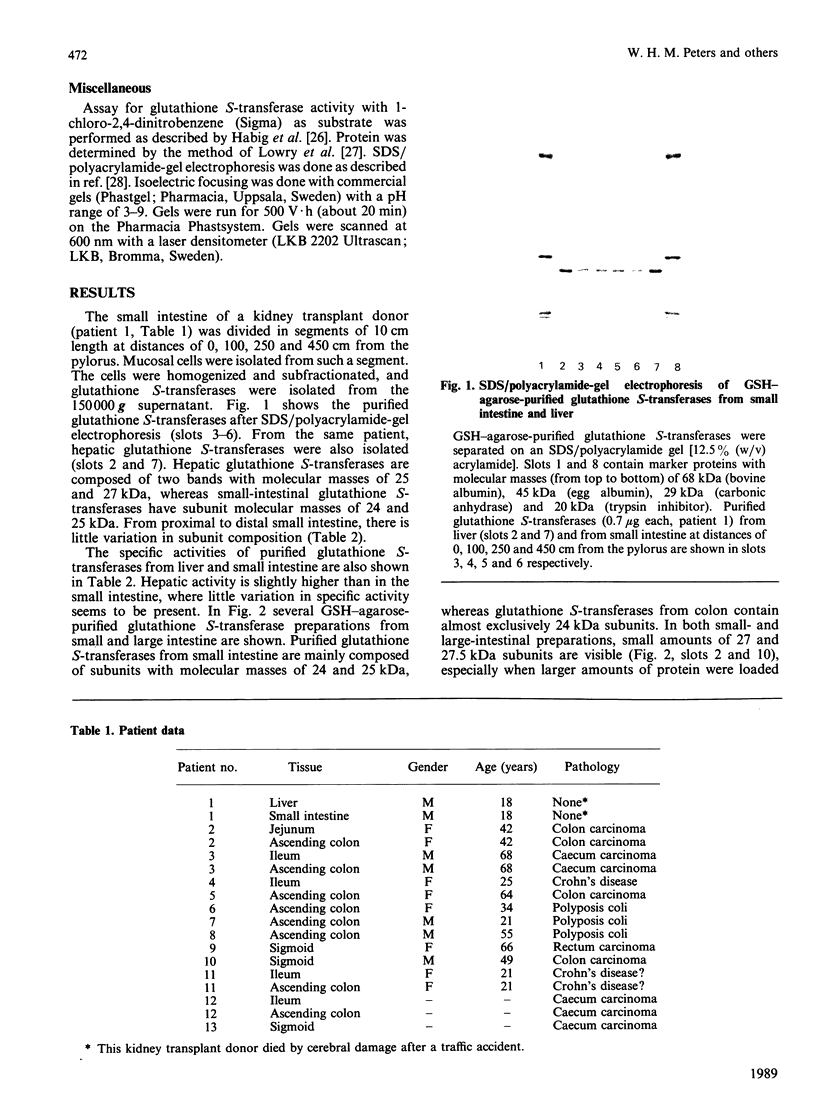

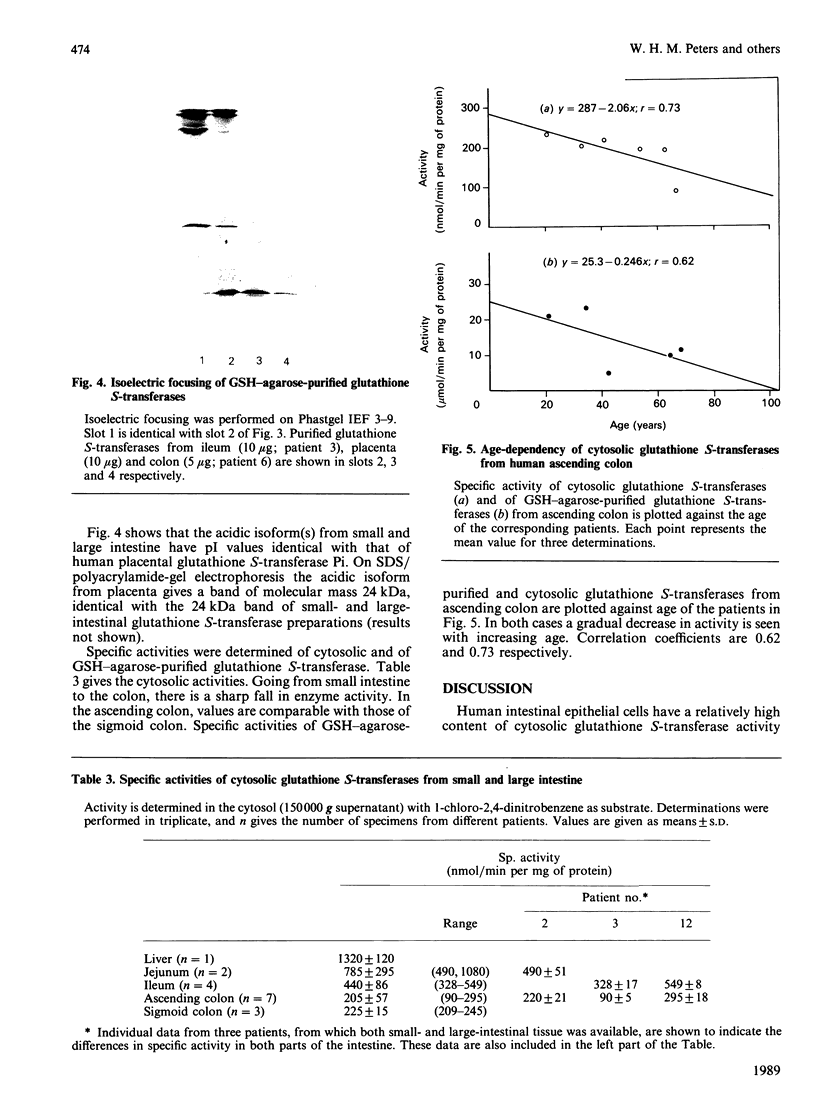
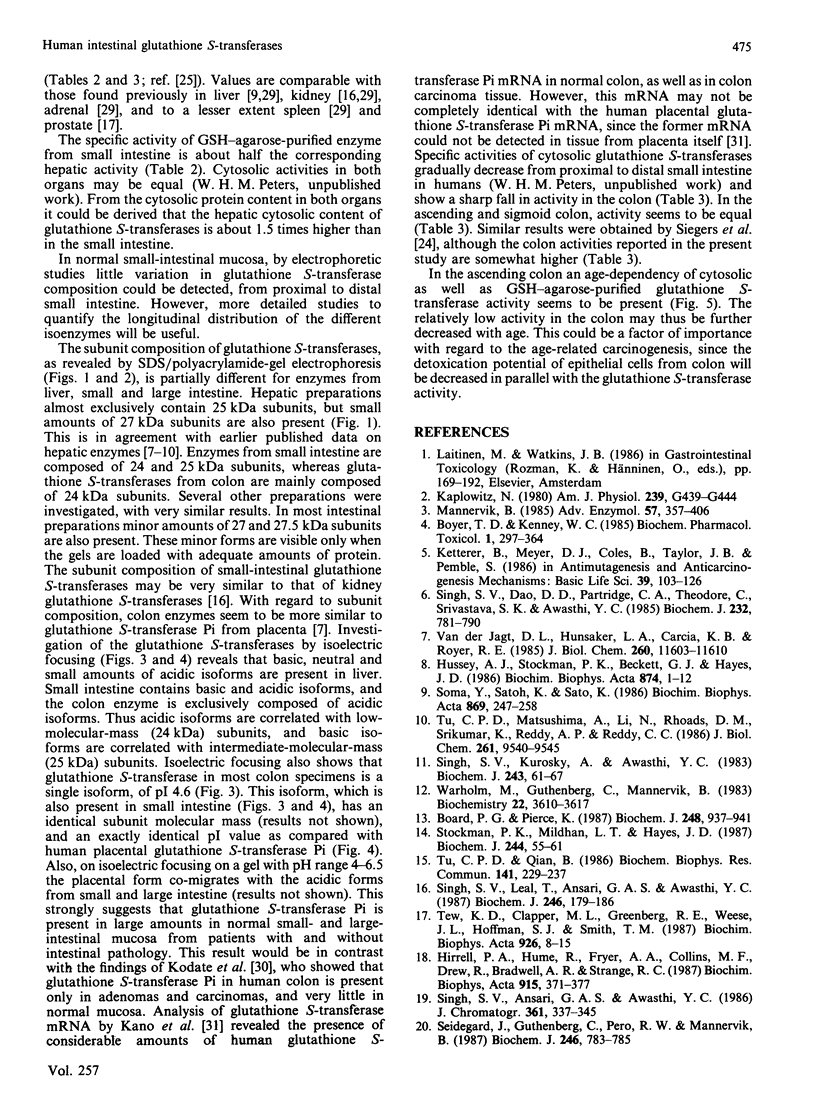
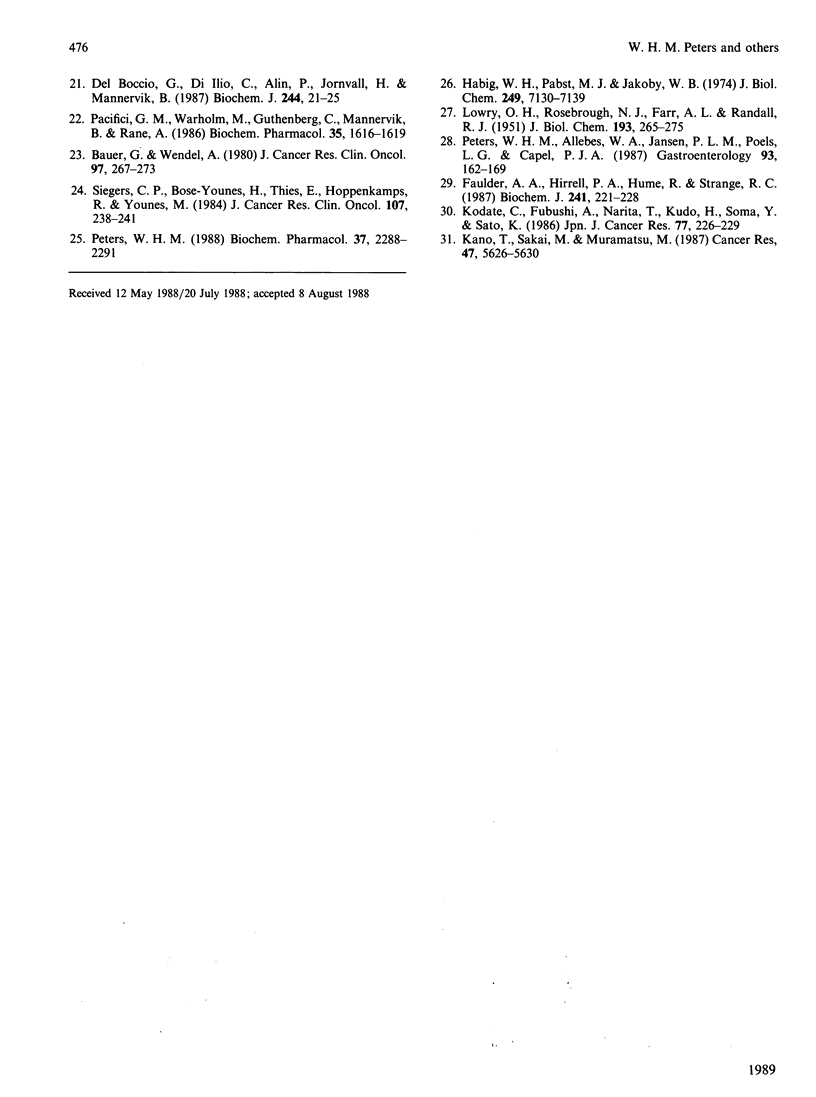
Images in this article
Selected References
These references are in PubMed. This may not be the complete list of references from this article.
- Baur G., Wendel A. The activity of the peroxide-metabolizing system in human colon carcinoma. J Cancer Res Clin Oncol. 1980;97(3):267–273. doi: 10.1007/BF00405778. [DOI] [PubMed] [Google Scholar]
- Board P. G., Pierce K. Expression of human glutathione S-transferase 2 in Escherichia coli. Immunological comparison with the basic glutathione S-transferases isoenzymes from human liver. Biochem J. 1987 Dec 15;248(3):937–941. doi: 10.1042/bj2480937. [DOI] [PMC free article] [PubMed] [Google Scholar]
- Del Boccio G., Di Ilio C., Alin P., Jörnvall H., Mannervik B. Identification of a novel glutathione transferase in human skin homologous with class alpha glutathione transferase 2-2 in the rat. Biochem J. 1987 May 15;244(1):21–25. doi: 10.1042/bj2440021. [DOI] [PMC free article] [PubMed] [Google Scholar]
- Faulder C. G., Hirrell P. A., Hume R., Strange R. C. Studies of the development of basic, neutral and acidic isoenzymes of glutathione S-transferase in human liver, adrenal, kidney and spleen. Biochem J. 1987 Jan 1;241(1):221–228. doi: 10.1042/bj2410221. [DOI] [PMC free article] [PubMed] [Google Scholar]
- Habig W. H., Pabst M. J., Jakoby W. B. Glutathione S-transferases. The first enzymatic step in mercapturic acid formation. J Biol Chem. 1974 Nov 25;249(22):7130–7139. [PubMed] [Google Scholar]
- Hirrell P. A., Hume R., Fryer A. A., Collins M. F., Drew R., Bradwell A. R., Strange R. C. Studies on the developmental expression of glutathione S-transferase isoenzymes in human heart and diaphragm. Biochim Biophys Acta. 1987 Oct 15;915(3):371–377. doi: 10.1016/0167-4838(87)90022-7. [DOI] [PubMed] [Google Scholar]
- Hussey A. J., Stockman P. K., Beckett G. J., Hayes J. D. Variations in the glutathione S-transferase subunits expressed in human livers. Biochim Biophys Acta. 1986 Nov 7;874(1):1–12. doi: 10.1016/0167-4838(86)90094-4. [DOI] [PubMed] [Google Scholar]
- Kano T., Sakai M., Muramatsu M. Structure and expression of a human class pi glutathione S-transferase messenger RNA. Cancer Res. 1987 Nov 1;47(21):5626–5630. [PubMed] [Google Scholar]
- Kaplowitz N. Physiological significance of glutathione S-transferases. Am J Physiol. 1980 Dec;239(6):G439–G444. doi: 10.1152/ajpgi.1980.239.6.G439. [DOI] [PubMed] [Google Scholar]
- Ketterer B., Meyer D. J., Coles B., Taylor J. B., Pemble S. Glutathione transferases and carcinogenesis. Basic Life Sci. 1986;39:103–126. doi: 10.1007/978-1-4684-5182-5_9. [DOI] [PubMed] [Google Scholar]
- Kodate C., Fukushi A., Narita T., Kudo H., Soma Y., Sato K. Human placental form of glutathione S-transferase (GST-pi) as a new immunohistochemical marker for human colonic carcinoma. Jpn J Cancer Res. 1986 Mar;77(3):226–229. [PubMed] [Google Scholar]
- LOWRY O. H., ROSEBROUGH N. J., FARR A. L., RANDALL R. J. Protein measurement with the Folin phenol reagent. J Biol Chem. 1951 Nov;193(1):265–275. [PubMed] [Google Scholar]
- Mannervik B. The isoenzymes of glutathione transferase. Adv Enzymol Relat Areas Mol Biol. 1985;57:357–417. doi: 10.1002/9780470123034.ch5. [DOI] [PubMed] [Google Scholar]
- Pacifici G. M., Warholm M., Guthenberg C., Mannervik B., Rane A. Organ distribution of glutathione transferase isoenzymes in the human fetus: differences between liver and extrahepatic tissues. Biochem Pharmacol. 1986 May 1;35(9):1616–1619. doi: 10.1016/0006-2952(86)90137-1. [DOI] [PubMed] [Google Scholar]
- Peters W. H., Allebes W. A., Jansen P. L., Poels L. G., Capel P. J. Characterization and tissue specificity of a monoclonal antibody against human uridine 5'-diphosphate-glucuronosyltransferase. Gastroenterology. 1987 Jul;93(1):162–169. doi: 10.1016/0016-5085(87)90329-5. [DOI] [PubMed] [Google Scholar]
- Peters W. H. Purification and partial characterization of human intestinal glutathione S-transferases. Biochem Pharmacol. 1988 Jun 1;37(11):2288–2291. doi: 10.1016/0006-2952(88)90596-5. [DOI] [PubMed] [Google Scholar]
- Seidegård J., Guthenberg C., Pero R. W., Mannervik B. The trans-stilbene oxide-active glutathione transferase in human mononuclear leucocytes is identical with the hepatic glutathione transferase mu. Biochem J. 1987 Sep 15;246(3):783–785. doi: 10.1042/bj2460783. [DOI] [PMC free article] [PubMed] [Google Scholar]
- Siegers C. P., Böse-Younes H., Thies E., Hoppenkamps R., Younes M. Glutathione and GSH-dependent enzymes in the tumorous and nontumorous mucosa of the human colon and rectum. J Cancer Res Clin Oncol. 1984;107(3):238–241. doi: 10.1007/BF01032615. [DOI] [PubMed] [Google Scholar]
- Singh S. V., Ansari G. A., Awasthi Y. C. Anion-exchange high-performance liquid chromatography of glutathione S-transferases. Separation of the minor isoenzymes of human erythrocyte, heart and lung. J Chromatogr. 1986 Jun 27;361:337–345. doi: 10.1016/s0021-9673(01)86923-5. [DOI] [PubMed] [Google Scholar]
- Singh S. V., Dao D. D., Partridge C. A., Theodore C., Srivastava S. K., Awasthi Y. C. Different forms of human liver glutathione S-transferases arise from dimeric combinations of at least four immunologically and functionally distinct subunits. Biochem J. 1985 Dec 15;232(3):781–790. doi: 10.1042/bj2320781. [DOI] [PMC free article] [PubMed] [Google Scholar]
- Singh S. V., Kurosky A., Awasthi Y. C. Human liver glutathione S-transferase psi. Chemical characterization and secondary-structure comparison with other mammalian glutathione S-transferases. Biochem J. 1987 Apr 1;243(1):61–67. doi: 10.1042/bj2430061. [DOI] [PMC free article] [PubMed] [Google Scholar]
- Singh S. V., Leal T., Ansari G. A., Awasthi Y. C. Purification and characterization of glutathione S-transferases of human kidney. Biochem J. 1987 Aug 15;246(1):179–186. doi: 10.1042/bj2460179. [DOI] [PMC free article] [PubMed] [Google Scholar]
- Soma Y., Satoh K., Sato K. Purification and subunit-structural and immunological characterization of five glutathione S-transferases in human liver, and the acidic form as a hepatic tumor marker. Biochim Biophys Acta. 1986 Feb 14;869(3):247–258. doi: 10.1016/0167-4838(86)90064-6. [DOI] [PubMed] [Google Scholar]
- Stockman P. K., McLellan L. I., Hayes J. D. Characterization of the basic glutathione S-transferase B1 and B2 subunits from human liver. Biochem J. 1987 May 15;244(1):55–61. doi: 10.1042/bj2440055. [DOI] [PMC free article] [PubMed] [Google Scholar]
- Tew K. D., Clapper M. L., Greenberg R. E., Weese J. L., Hoffman S. J., Smith T. M. Glutathione S-transferases in human prostate. Biochim Biophys Acta. 1987 Oct 8;926(1):8–15. doi: 10.1016/0304-4165(87)90177-2. [DOI] [PubMed] [Google Scholar]
- Tu C. P., Matsushima A., Li N. Q., Rhoads D. M., Srikumar K., Reddy A. P., Reddy C. C. Immunological and sequence interrelationships between multiple human liver and rat glutathione S-transferases. J Biol Chem. 1986 Jul 15;261(20):9540–9545. [PubMed] [Google Scholar]
- Tu C. P., Qian B. Human liver glutathione S-transferases: complete primary sequence of an Ha subunit cDNA. Biochem Biophys Res Commun. 1986 Nov 26;141(1):229–237. doi: 10.1016/s0006-291x(86)80358-8. [DOI] [PubMed] [Google Scholar]
- Vander Jagt D. L., Hunsaker L. A., Garcia K. B., Royer R. E. Isolation and characterization of the multiple glutathione S-transferases from human liver. Evidence for unique heme-binding sites. J Biol Chem. 1985 Sep 25;260(21):11603–11610. [PubMed] [Google Scholar]
- Warholm M., Guthenberg C., Mannervik B. Molecular and catalytic properties of glutathione transferase mu from human liver: an enzyme efficiently conjugating epoxides. Biochemistry. 1983 Jul 19;22(15):3610–3617. doi: 10.1021/bi00284a011. [DOI] [PubMed] [Google Scholar]




